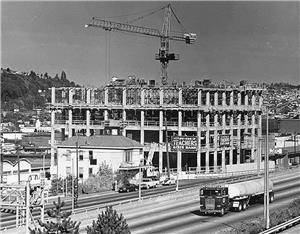On October 1, 1971, pioneer financier Joshua Green (1869-1975) presides at the opening of Teachers State Bank in Seattle. As The Seattle Times reports, the "oldest banker in state opens its youngest bank." The new bank represents the fruition of a long effort by credit union and insurance executives Robert J. Handy (1901-1984) and Stanley O. McNaughton (1921-1998). It will be renamed Evergreen Bank in 1980, and affiliate with PEMCO Financial Services and the School Employees Credit Union of Washington.
"Money When You Need It"
Evergreen Bank was conceived by Handy and McNaughton in the late 1960s as an essential element within the emerging constellation of PEMCO Financial Services. PEMCO itself was an outgrowth of the Seattle Teachers' Credit Union, (now School Employees Credit Union of Washington), founded by Handy in 1936, and of subsequent insurance providers organized by Handy and PEMCO chief executive officer Stanley O. McNaughton.
Handy and McNaughton's goal was to be able to offer credit union members and PEMCO customers "money when you need it," but to achieve the goal they had to overcome several obstacles. Established banks strenuously objected to the formation of a new bank in Seattle, fearing state educators would abandon them en masse because of the success of Handy's credit union. The regional economy had also taken a dramatic nosedive with the "Boeing Bust" of the late 1960s and early 1970s. Handy and McNaughton responded by organizing support from residents and businesses in Seattle's Cascade Neighborhood, where the new bank was to be located and which was not then served by any convenient bank branches.
Teachers State Bank won its state charter on January 27, 1971. Former Peoples Bank president Clare Geddes served as its first president. Founding employees included Marcie Duncan, Carol Buckles, and Jackie Bender. The bank occupied headquarters at the PEMCO Financial Center in 1983, and opened a branch in the north Seattle suburb of Lynnwood in 1992.
The bank's early growth was slowed by the public misconception that only teachers could open deposits in it. In order to broaden the bank's appeal, the name was changed to Evergreen Bank on March 14, 1980. The strategy worked. By 1990, Evergreen Bank assets topped $100 million.
Evergreen Bank failed during the Great Recession that began in 2008 and was closed in January 2010. Its assets and branches were transferred to Umpqua Bank, headquartered in Oregon.

